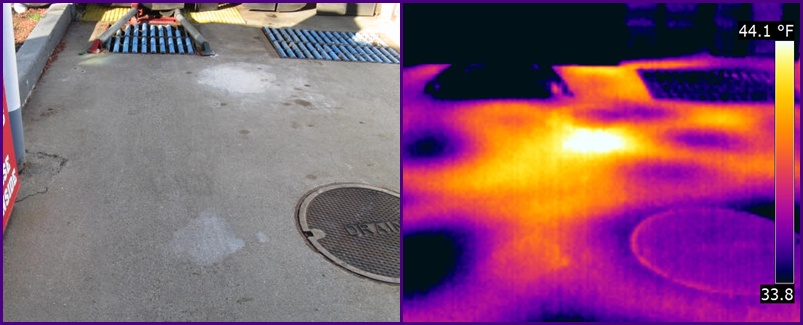Ice and snow melt systems are utilized in many applications throughout
the state of Massachusetts. Business owners utilize snow and ice melt
systems in outdoor malls, parking lots, car washes, walkways, and
loading ramps to eliminate the expense of continuous snowplowing, to
avoid skidding of vehicles and to prevent slip-and-fall accidents on
their property.
As a convenience, homeowners of upper-end homes install ice and snow
melt heating systems in their exterior slabs...including driveways,
sidewalks, stairs, and patios to completely eliminate the need for any
back breaking shoveling or snow removal.
There are two types of ice and snow melt systems in Massachusetts ---
embedded electric heat cables and hydronic piping. In my experience most
of the ice and snow melt systems in Massachusetts are predominately
hydronic systems. This is basically a closed-loop tubing made of a
flexible polymer (typically a cross-linked polyethylene) or a synthetic
rubber that circulates a mixture of hot water and propylene glycol
(antifreeze), much like the mixture used in an automobile radiator. A
boiler will warm the fluid to temperatures of 140 to 180 F. which will
provide sufficient heat throughout an exterior surface for melting any
snow that may have the ability to accumulate. The concealed ice melt
tubing ranges in diameter from 1/2 to 3/4 inch and is flexible enough to
bend into various spiral or serpentine patterns (as seen in my infrared
images below) to allow for an even heat distribution and warm up any
exterior surface.

These in-slab snow melt systems are designed to have a long service
life, but everyone knows that continuous use of any material will not
last forever. When these embedded systems do fail, a plumbing repair is
imminent. The problem with repairing this system is that the heating
elements are completely embedded, and any repairs that need to take
place are very difficult because the concrete around the damaged section
of the embedded piping must be removed first. Locating and pinpointing
the exact area of a rupture in any large ice and snow melt system is
completely impossible with a visual inspection, so detecting the exact
trouble spot is where Thermal Imaging comes into play.
A rupture in concealed hydronic tubing can easily be detected with a
simple Infrared (Thermal) scan. There’s no guesswork involved. I simply
pan the entire snow and ice melt surface with my infrared camera and it
enables me to clearly detect every embedded heat pipe within minutes of
heating up the system. If there are any ruptures, breaks or leaks in the
concealed piping system, it will clearly show up as an anomaly and this
defective area can now be marked out with a temporary spray paint with
precision. This area of concern can now be carefully excavated
(attempting to avoid damaging the existing piping) and the piping can
then be properly repaired. Once the repair is completed, the breached
material can then be re-patched. Infrared detection will always keep
your repair work down to a bare minimum.

Massachusetts based Ernie Bach Jr. Honda
dealership had a major leak in their ice and snow melt system, but was
unable to pinpoint the concealed pipe leak visually.My infrared scan detects and pinpoints the exact location of the ruptured pipe within minutes.
Infrared imaging allows me to detect the exact area of a pipe burst in this radiant ice and snow melt system.
An automatic car wash (installed right above an
ice and snow melt system) had to be replaced without disturbing the
concealed radiant heat piping that is below it.
My infrared scan made this heavy duty car wash
machinery replacement possible without disturbing the heat pipes
embedded in the concrete floor below it.
A temporary orange marking paint was utilized to
identify all the concealed pipe locations. Marking these concealed pipe
locations gave the installers a guideline to install the new automatic
car wash. You can clearly see that embedded ice melt piping will never
be completely straight.
Thermal imaging allows me to easily detect and
pinpoint the exact location of the main supply line for this radiant ice
and snow melt system.
Another automatic car wash upgrade requires
infrared scanning in order to detect the exact location of all embedded
piping. You can clearly see how these buried pipes will not remain
perfectly straight when contractors pour concrete over them. Note the
two foot void on the left.
After mapping out the embedded pipes within this
car wash bay (above), the automatic car wash was bolted to this floor
with no issues.
This is another car wash with a radiant ice melt
system that had failed. You can clearly see the bright yellow area where
the embedded piping has failed.
The concrete floor was then breached and a
Plumber successfully repaired the damaged pipe without having to tear up
the entire car wash bay.
Another embedded pipe that has failed. This leak is easily detected by the bright yellow mass on the infrared image.
After breaching this concrete floor, the active leak was obvious.
Here is another embedded radiant heat pipe that
has failed on an exterior walkway. Note the bright yellow mass on the
infrared image.
After breaching this concrete walkway, the leaking pipe was obvious.
This ice melt system has been "ON for
approximately one hour. I am now detecting an embedded pipe leak at the
bright yellow area.
It gets worse. See next two images...
Looking in the opposite direction, this ice melt
system was looking good with no leaks. But after waiting over an hour, I
detect major issues. See next image....
Infrared detects another bright yellow area which
is indicative of another defective embedded pipe. This entire system
must be repaired or replaced immediately.
























No comments:
Post a Comment